Over the past few years, I’ve been enjoying rediscovering a type of camera that I’d somehow “leapfrogged” past in my youthful headlong rush to transition from more basic equipment to the vaunted SLR – the compact rangefinder types including models from Canon, Konica, Minolta, Olympus, and Yashica.
Perhaps you’ll enjoy journeying along with me for some experiences – and photos – with each of my “new” compact rangefinders in months ahead.
This post is about my Canon Canonet QL17 GIII, which I feel to be an excellent exemplar of the genre.
I should point out, I did sojourn briefly with rangefinders on the way to the SLR, with a couple of big beefy models from Konica and Minolta. But this newly awakened interest had to do with that popular (and often even elegant) sub-specie of the “full-size” or traditional rangefinder camera, hence my reason for italicizing the word “compact.”
It’s not as though this “rediscovery” has caused me to turn away from the SLR. No chance of that! What they have done, though, was to bring another enjoyable dimension to the shooting experience. As in, let’s build a shoot around seeing the world around me exclusively through a 40mm perspective. No zoom-zoom. We’ll do that with the feet.
As someone who has “schlepped” his share of heavily stuffed camera bags on this or that photo jaunt (or trek), this can be nothing short of liberating. No worries about what I might be missing by leaving that heavy f/2.8 70-200mm professional lens or the variety of primes at home. Just the one lens – the one on the camera! – and perhaps a few filters according to the film I plan to shoot.
Neck to photographer – “Thank you, my dear, thoughtful friend.”
About those compact rangefinders…
These cameras were designed for “casual” shooters for whom the allure of interchangeable lenses was not a big thing. They also pre-dated cameras with built in – but often rather so-so – zoom lenses. And the form factor fit right in with the intent – not threateningly large and bulky, but pleasingly compact, yet with an undeniable solidity.
The Canon Canonet QL17 GIII – now there’s a great big name for a small camera! – was a line of compact rangefinder cameras built by Canon in the 1970s and targeted at those “casual” shooters.
Now, in this era of camera phones, selfie-sticks, Instagram, instant-bloody-everything, “casual shooter” is likely to have a vastly different connotation than it did in the era of the compact rangefinder film camera.
Back in the day, the user was expected to expend at least the modest effort of determining that the subject was in focus. Oh yes, and to set the film sensitivity on the camera’s ISO dial (back then, it was actually called ASA, but same values). And, if it wasn’t asking too much, to make other inputs to the process that would ensure that the camera would create the kind of image they were seeking. And that required at least a casual knowledge of the relationships between f/stops and shutter speeds to determine desired motion stopping, or depth of focus.
We probably didn’t appreciate it then, because, at least in the ‘60s and ‘70s, camera manufacturers had not yet transitioned to lightweight plastic. These were precision machines – lots of metal, inside and out, with lovely, fast lenses of serious design. They were not the throwaway “commodities” we see nowadays along with their built-in obsolescence. The solidity of build means there’s a pretty good chance that – even after hibernating in someone’s drawer or being cast off, Velveteen Rabbit style, in some thrift shop – inserting a fresh battery for the meter might just wake up the little guy to where he’s ready to go on that photo walk with you. And, if not, well, he’s certainly worth the cost of a professional CLA with some new light seals thrown in for good measure to ensure another 50 years of happy use.
Now, how many of today’s “casual-use” consumer goods can you say that about?
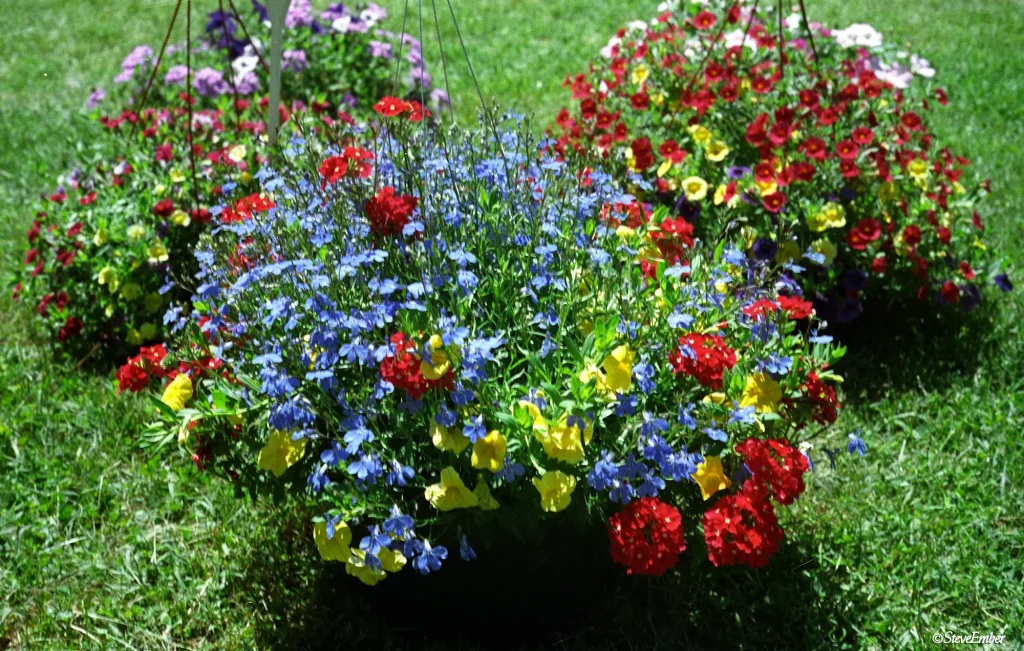
So, on to my “new” 1970s vintage Canonet QL17 GIII and its maiden outing.
But first, if you’re at all curious about all those letters and numbers in the camera’s name.
QL stood for the quick loading mechanism, whereby the user simply pulls a short length of film out of the cassette and across the back of the camera and closes the door. No, there’s no whizzing sound as the camera winds off the first few frames to get to Frame No.1. The process is manual, so a few strokes of the nice solid winding lever (making sure the rewind crank is turning backwards) and you’re ready to shoot.
17 was Canon shorthand for the bright – and very sharp – f/1.7 lens.
And the GIII simply signified this was the third (and final) “grade-up” in this long and very successful line that debuted in 1969. The GIIIs were manufactured between 1972 and 1982 and, according to Canon, more than 1.2 million of them were sold.
In stepping into the compact rangefinder waters, my approach has been to look for very clean examples that have recently been adjusted, checked, and had their light seals replaced. I suppose this goes counter to the bargain-hunters’ happy tales of picking up a fully-functioning example at a rummage sale for a few bucks and bringing it back to life by simply inserting a new battery. For every one of these bargains, my hunch is that there are twenty or more with age-crumbling seals, sticking shutters, and the dreaded black tendrils of fungus blooming in the lens or the viewfinder. No, thank you.
Thus, my Canonet arrived in lovely condition with a clear and bright viewfinder and smoothly functioning controls. I fortunately had a PX-625 mercury battery, around whose voltage and stability the Canonet QL17 GIII was designed, so I felt confident in using slide film for the camera’s maiden shoot. That medium would also confirm important information as to shutter and metering accuracy.
The destination was the Historic District of Annapolis, Maryland.
The calendar may have said early spring – it was March 29 – but the trees and sunlight definitely said “winter.” I loved the well defined shadows that those bare-limbed trees were casting on walls and sidewalks as I explored along Duke of Gloucester Street. In the foreground is the inviting Georgian House bed and breakfast, which occupies a handsome pre-Revolutionary home built in 1747.
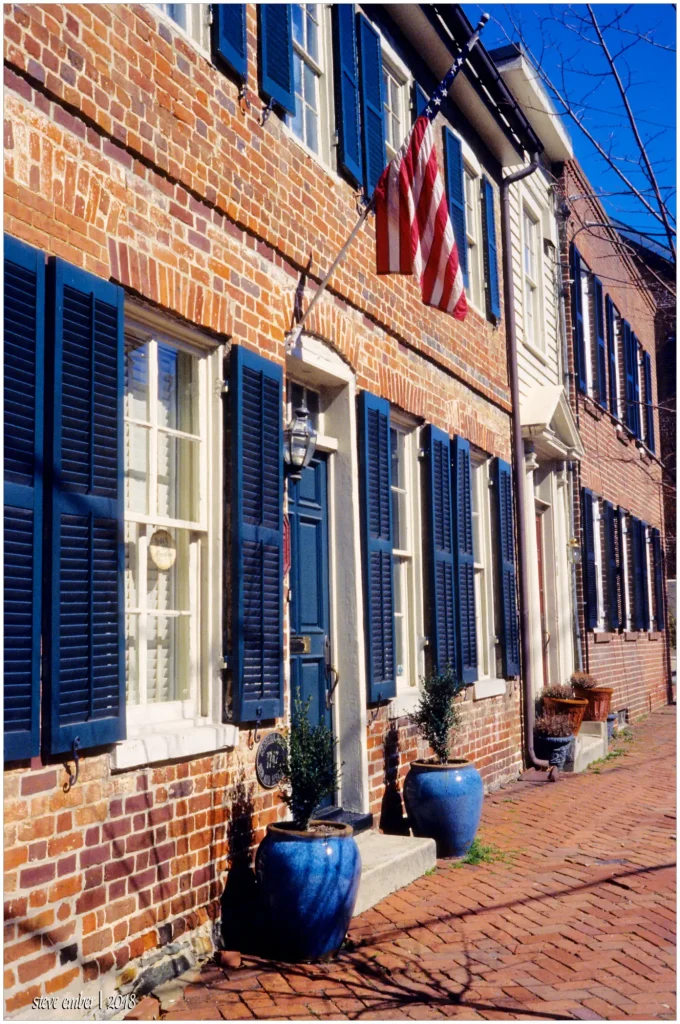
Ektachrome ©Steve Ember
The rich earth-toned textures of old brick and the harmonizing deep blues of shutters, door, and sky in the crisp late winter sunshine provided an inviting motif for the Ektachrome to capture via the Canonet’s lovely and bright 40mm lens.
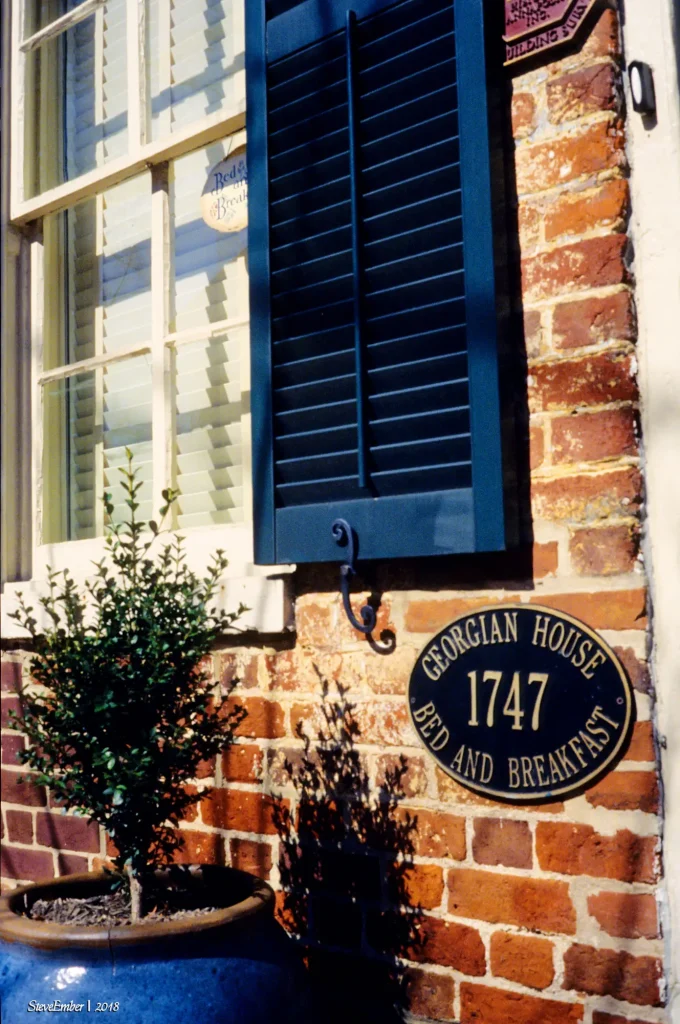
Ektachrome ©Steve Ember
Canon designed the QL17 as a shutter priority camera. Thus, one sets an appropriate shutter speed for the type of shot and an easy to read scale along the right side of the viewfinder tells you the aperture the meter has selected. If you prefer more (or less) depth of field, simply readjusting the shutter speed on the lens barrel will allow such changes. As I recall, in the Annapolis shooting, I favored 1/60 of a second to set smallish f/stops, allowing a nice depth of focus for the type of cityscapes I was shooting.
As I’ve become more comfortable with the Canonet QL17 GIII, I’ve occasionally used slower shutter speeds, as the combination of leaf shutter and camera heft – along with the (almost) wide-angle focal length of 40mm – allows successful shooting where those slow speeds are necessary or desired for small aperture depth of field.
Incidentally, the Canonet QL17 GIII can also be used in full manual mode, should that be your preference for special effects, tricky lighting where the meter might get fooled, or if the battery should die. One simply rotates the aperture ring from “A” (Auto) to the chosen f/stop and selects an appropriate shutter speed. In this mode, the camera’s meter does not function.
For this exigency, I did carry along my tiny Voigtländer clip-on meter. I was actually quite pleased that the 30-odd year old meter in the Canonet agreed with the new Voigtländer in most situations. Incidentally, all five photos included here were shot with the Canonet’s own meter.
Up Duke of Gloucester Street from the Georgian House B&B was another handsome brick dwelling, this one whitewashed, with a magnificent old tree beside it casting dramatic shadows in the winter sunshine. The motif suggested the black and white treatment I subsequently created from the original Ektachrome frame on that first roll.
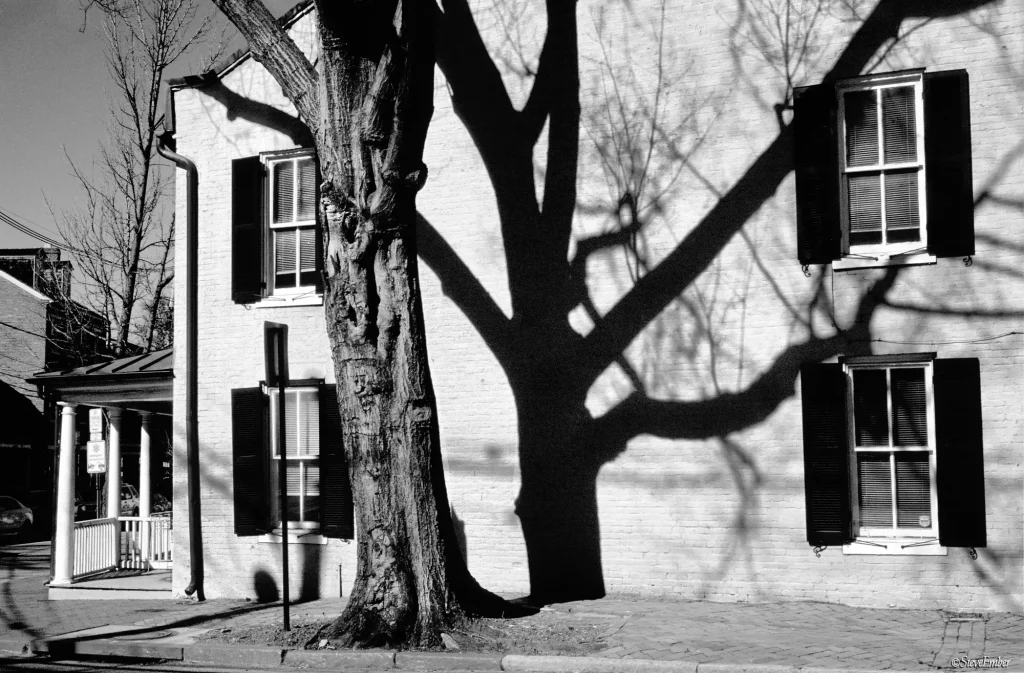
From Duke of Gloucester Street, my Annapolis perambulations led to some nearby aspects of Maryland’s capital city.
The City Dock was home on this afternoon to the 1902-built skipjack “Stanley Norman” which speaks to the Chesapeake Bay’s oystering tradition. When not visiting the City Dock, she’s tied up at the Annapolis Maritime Museum, across Spa Creek from downtown Annapolis in Eastport.
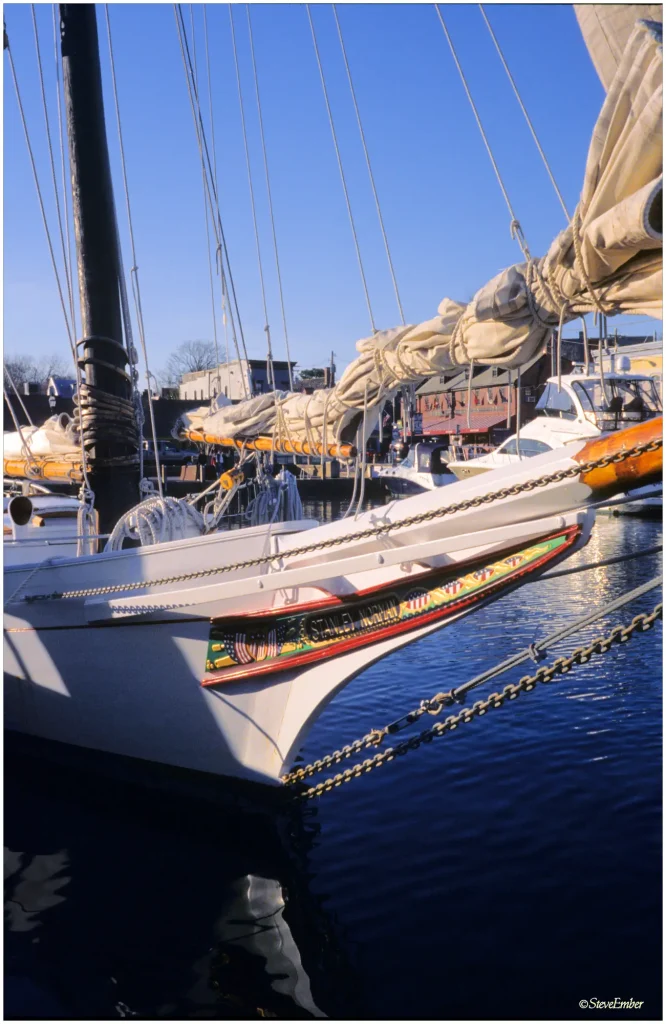
And, up Main Street from the City Dock, one finds one of old-town Annapolis’s shopping and restaurant stretches, leading up the hill to Church Circle. A stop here for the fifth of my five frames with the Canonet and a motif warm and fuzzy in the sunshine of this late winter afternoon.

Ektachrome ©Steve Ember
After Annapolis…
A subsequent outing with the Canonet QL17 GIII involved a visit to the Baltimore Herb Festival at Leakin Park on a photo-enticing May afternoon, this time using some (freezer-stored) Agfa-manufactured ISO-200 color negative film. I loved the character in this woman’s face, as she sat on a shaded porch and wove some tales.
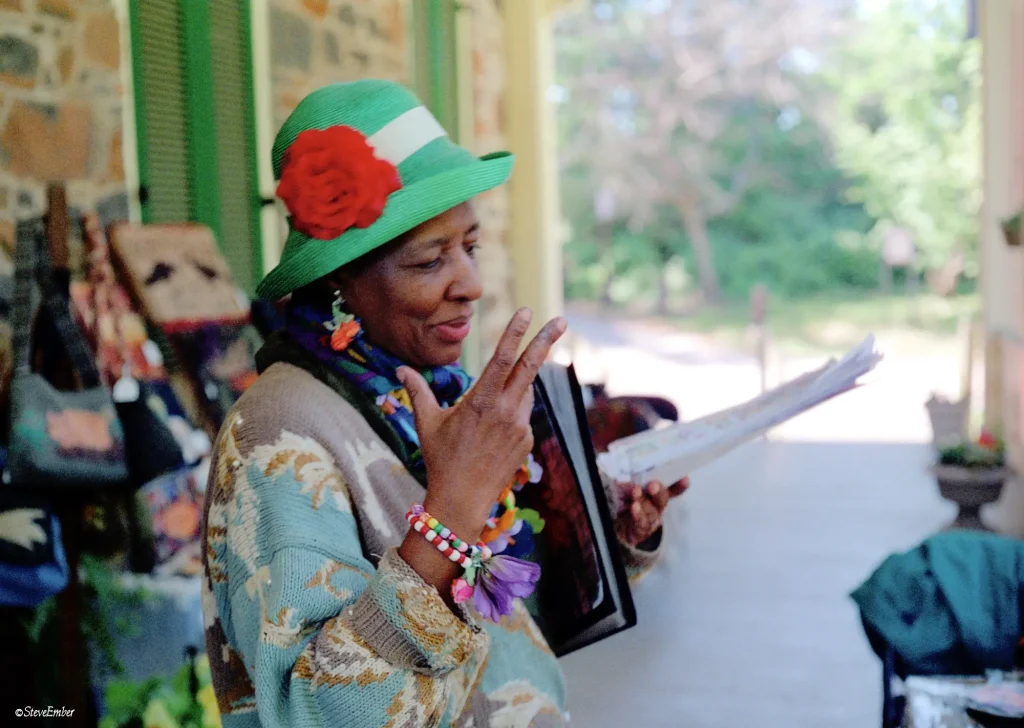
And, while I did have a rather large film SLR along on this visit, I really appreciated how the Canonet’s smallish lens allowed me to maneuver the camera inside the wire mesh fence to photograph this sun-warmed “pile” of goats. Their owner was vigilant in keeping these furry “lawn-chompers” where their “munching” tendencies would not interfere with the day’s commerce.
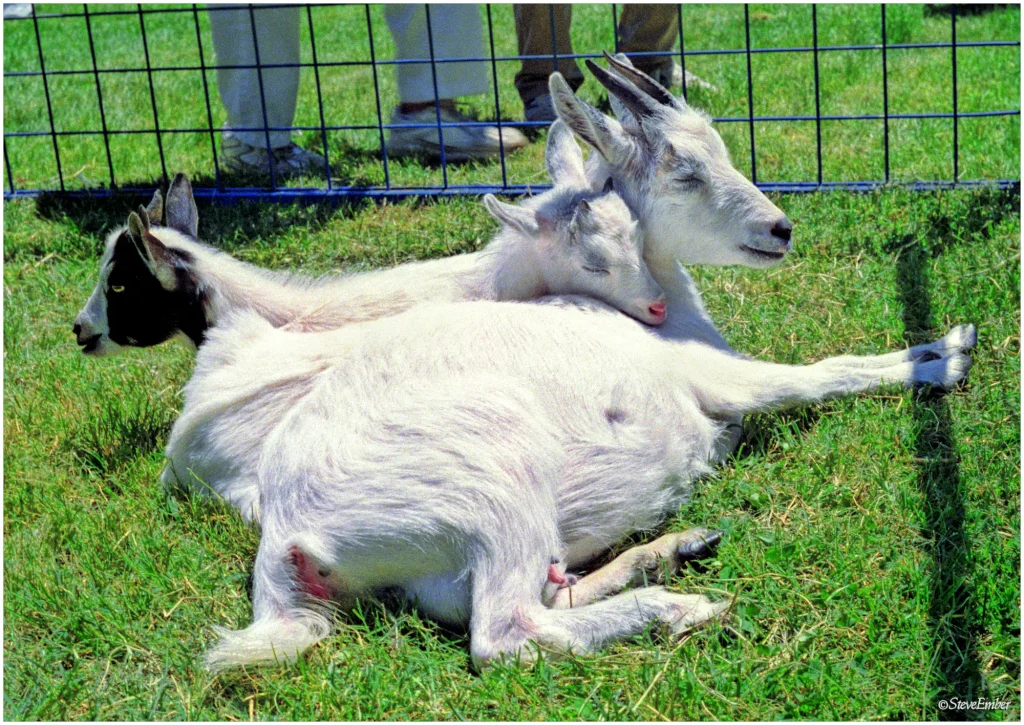
On an equally pleasant sunny afternoon, this time closer to home in northern Virginia I stopped at the gleaming Silver Diner in Merrifield to capture a bit of Americana in the bright afternoon sunshine. For this one, I decided to use a polarizing filter to make the sky a bit more dramatic. Using such a filter on a compact rangefinder is a bit more labor intensive than doing same on an SLR, as there is no way to assess the desired polarizing effect through the camera’s viewfinder. Fortunately, my Heliopan polarizer has index markings, so after holding it off-camera, noting the number at the top center position on the filter’s rim, and screwing it back onto the lens, making sure that number appears in the same position, it can be done – just a bit of patience required. And, as the Canonet incorporates its meter sensor in the lens mount, there are no worries about calculating a filter factor to dial in.
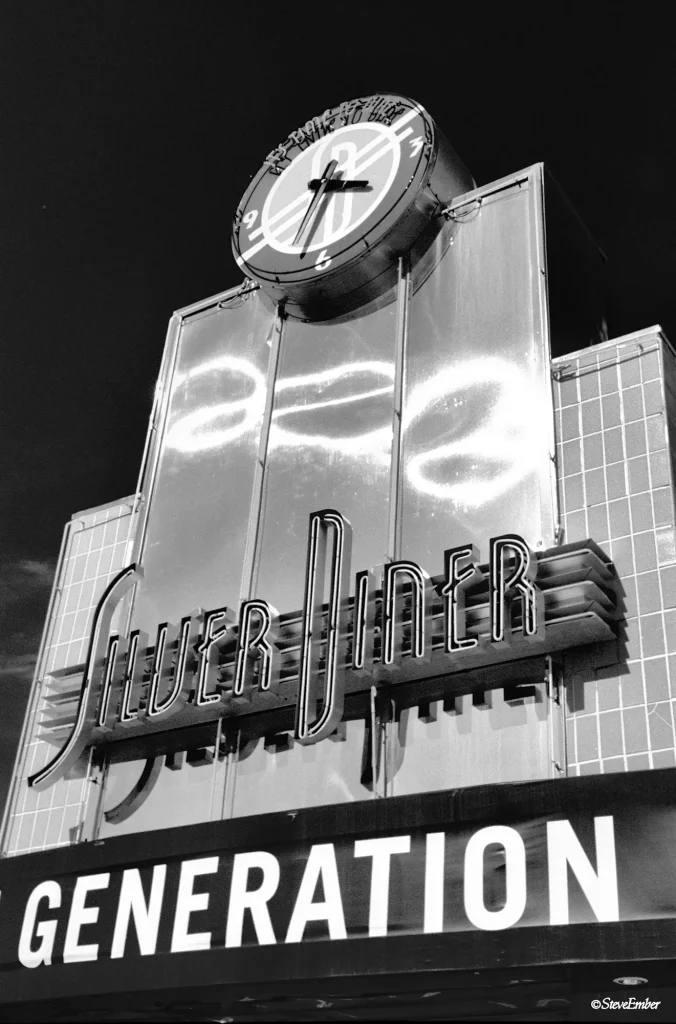
Incidentally, Canon designed a companion flash unit for the Canonet QL17 GIII, called the Canolite 14. When attached, it can be used with the camera’s very helpful flash mode, which sets an appropriate f/stop according to the focused distance. I tried this out on my cousins’ very large and inquisitive cat “Chuckie,” who was intent on finding some catnip growing among the flowers on their deck.
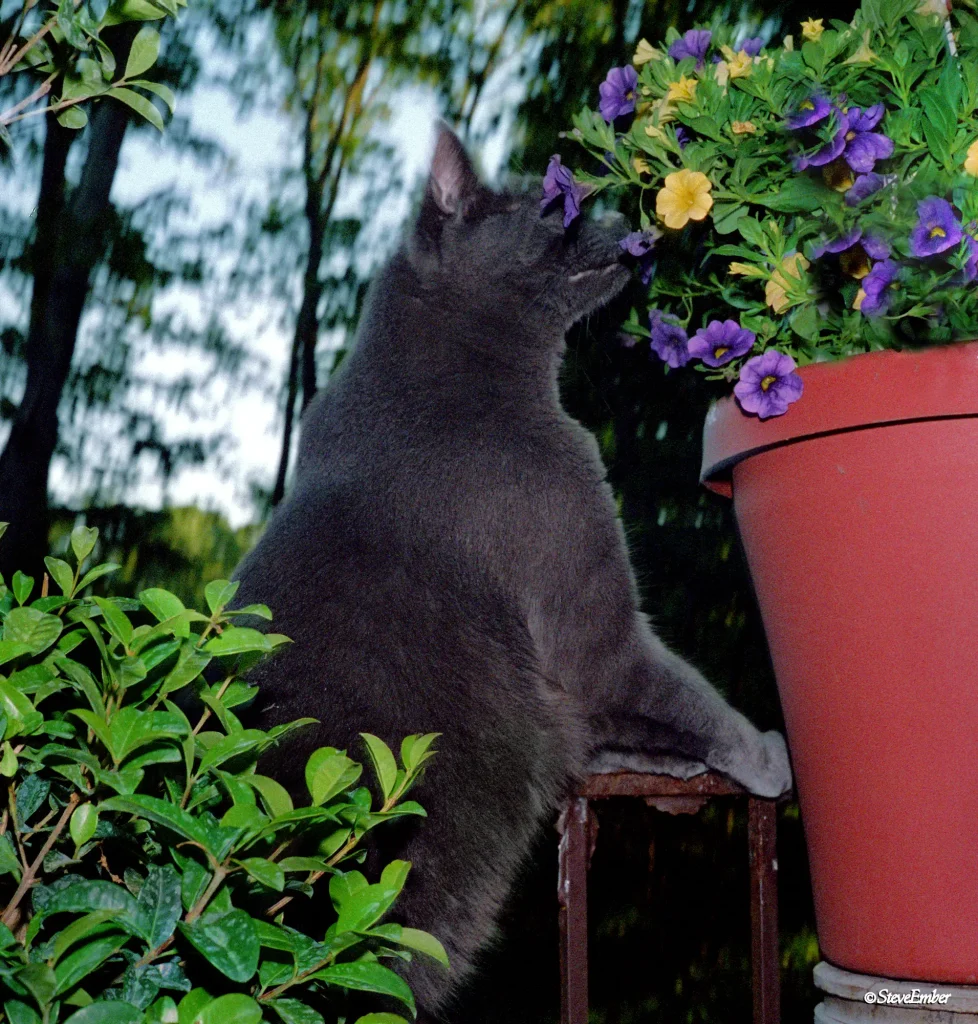
By the way, about that compact rangefinder nomenclature, I should mention that the Canonet QL17 GIII is actually one of the “larger” cameras of this class, at least compared to the others I added during my voyage of re-discovery. Compared to the Konica C35 and Auto S3, the Minolta HiMatic 7SII, and the Olympus RD, it is a bit beefier, but it feels just fine in my large hands. Let me take you along for some shoots with those “smaller” compact rangefinders another time.
Cheers, and happy film shooting!
©2018 Steve Ember
Share this post:
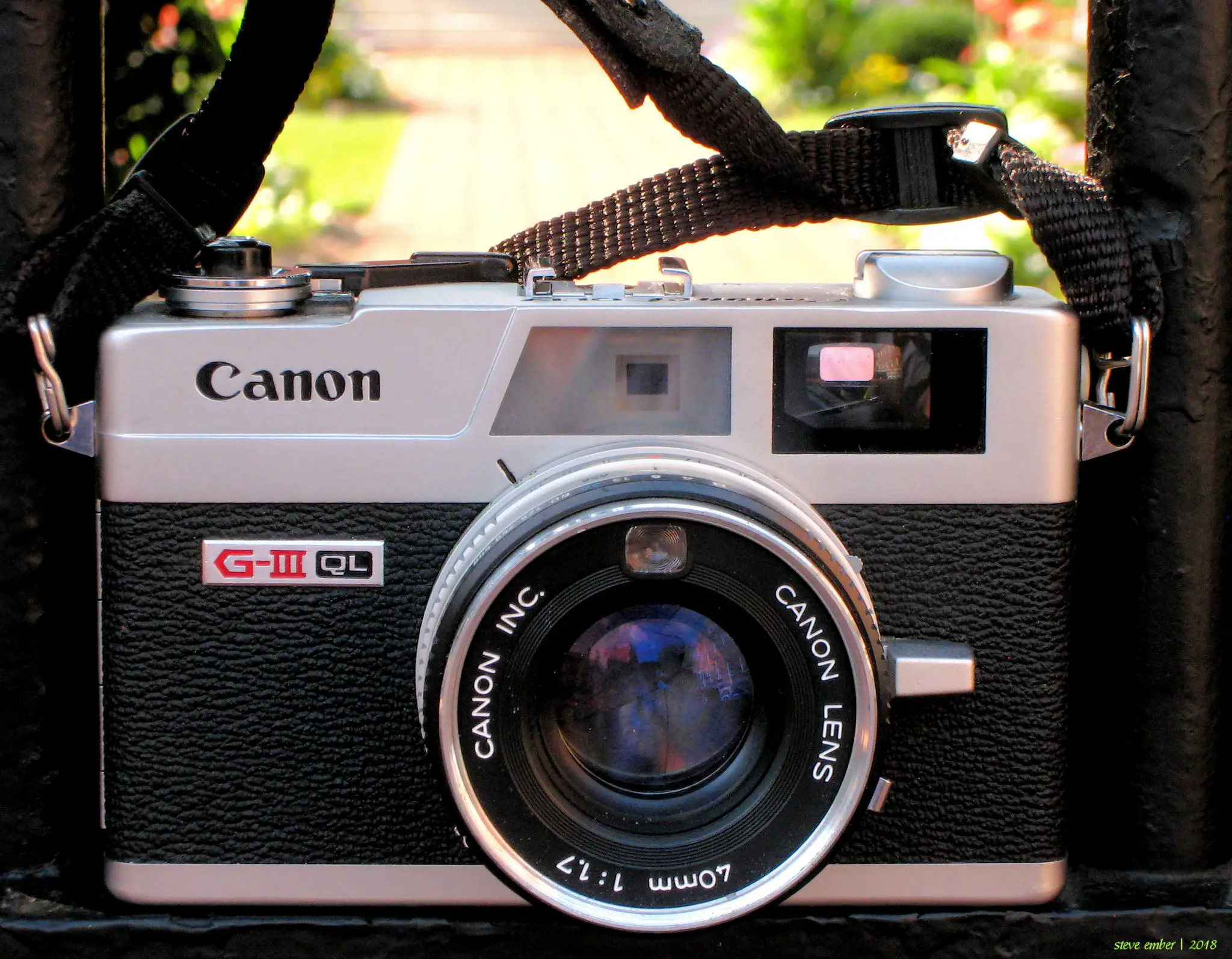








Comments
Danny on Canon QL17 Giii review – Discovering cameras I’d Missed Along the Way – Part 1 – By Steve Ember
Comment posted: 21/12/2018
Comment posted: 21/12/2018
Eric on Canon QL17 Giii review – Discovering cameras I’d Missed Along the Way – Part 1 – By Steve Ember
Comment posted: 21/12/2018
Comment posted: 21/12/2018
Comment posted: 21/12/2018
Terry Sankey on Canon QL17 Giii review – Discovering cameras I’d Missed Along the Way – Part 1 – By Steve Ember
Comment posted: 21/12/2018
Comment posted: 21/12/2018
Laurie on Canon QL17 Giii review – Discovering cameras I’d Missed Along the Way – Part 1 – By Steve Ember
Comment posted: 21/12/2018
Comment posted: 21/12/2018
Brian on Canon QL17 Giii review – Discovering cameras I’d Missed Along the Way – Part 1 – By Steve Ember
Comment posted: 22/12/2018
I'll be interested to see which cameras you select next. Many great ones to choose from. My first 35mm camera is the Minolta Hi-Matic 9, bought in 1969. Still works. It is a full-sized camera, a 45mm F1.7 lens- same basic optical formula as the Minolta 50/1.8 in Leica mount. The latter will run 10x what the HM9 cost.
I remember "in the day" several Wedding Photographers that I knew kept a Fixed-Lens RF with them for shooting weddings. They are quiet, and have fast lenses. Are great for candid shots.
Comment posted: 22/12/2018
Comment posted: 22/12/2018
Comment posted: 22/12/2018
Christos Theofilogiannakos on Canon QL17 Giii review – Discovering cameras I’d Missed Along the Way – Part 1 – By Steve Ember
Comment posted: 22/12/2018
Comment posted: 22/12/2018
Ian Ronketti on Canon QL17 Giii review – Discovering cameras I’d Missed Along the Way – Part 1 – By Steve Ember
Comment posted: 22/12/2018
Comment posted: 22/12/2018
Brian on Canon QL17 Giii review – Discovering cameras I’d Missed Along the Way – Part 1 – By Steve Ember
Comment posted: 23/12/2018
Comment posted: 23/12/2018
Comment posted: 23/12/2018
eric on Canon QL17 Giii review – Discovering cameras I’d Missed Along the Way – Part 1 – By Steve Ember
Comment posted: 24/12/2018
With a mint rangefinder of this time you ate not going wrong. You will get equivalent results to which you get with a Summicron-c 40 or Rokkor 40 with a CL a CLE or Leica for half of the price.
These cameras are top to discover or rediscover film photography.
Comment posted: 24/12/2018
The Canon Demi EE17 - A Surprisingly Good Half Frame Camera - By Phil Stefans - 35mmc on Canon QL17 Giii review – Discovering cameras I’d Missed Along the Way – Part 1 – By Steve Ember
Comment posted: 22/02/2019
John Rolling on Canon QL17 Giii review – Discovering cameras I’d Missed Along the Way – Part 1 – By Steve Ember
Comment posted: 11/06/2020
Steve Ember on Canon QL17 Giii review – Discovering cameras I’d Missed Along the Way – Part 1 – By Steve Ember
Comment posted: 06/09/2020
Rezha on Canon QL17 Giii review – Discovering cameras I’d Missed Along the Way – Part 1 – By Steve Ember
Comment posted: 22/01/2022
Comment posted: 22/01/2022
Les Berkley on Canon QL17 Giii review – Discovering cameras I’d Missed Along the Way – Part 1 – By Steve Ember
Comment posted: 21/11/2022
Comment posted: 21/11/2022